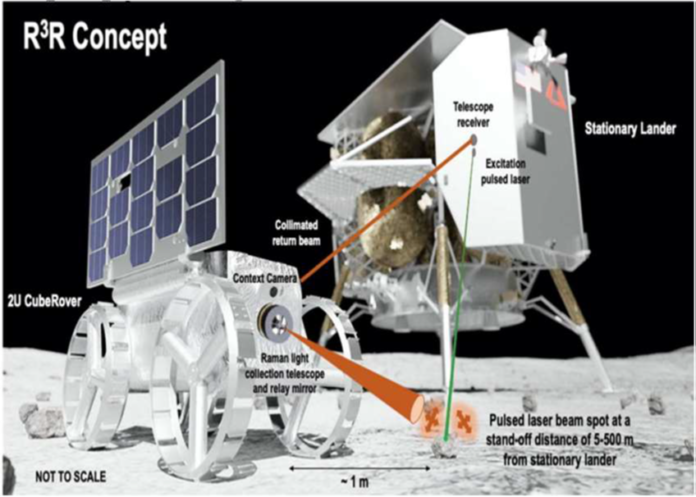By Laurence Tognetti, MSc
May 27, 2025
Raman spectroscopy uses scattered to identify a substance’s chemical ingredients and is one of the most widely used scientific methods in space exploration. It is used for lunar exploration to identify volcanic minerals, water ice, and space weathering, and has been limited to obtaining data from lunar orbiters. But how can Raman spectroscopy be conducted on the lunar surface to help us better understand our nearest celestial neighbor? This is what a recent study presented at the 56th Lunar and Planetary Science Conference hopes to address as a team of NASA and academic researchers discussed the Raman Cube Rover (R3R), which would be delivered to the lunar surface via the private space company, Astrobotic.
For the study, the researchers discussed the development of the Raman Cube Rover with laboratory experiments and how it can contribute to future Artemis missions to the lunar surface. These experiments involved testing three optical configurations for collecting data, including collecting data using a spectrometer and optical fiber via direct contact from the laser beam to the sample and indirect contact using a mirror, and using scattered light combined with a long-distance microscope to collect the data. The researchers note how the Raman Cube Rover’s resolution has demonstrated an approximate distance of 30 meters (98 feet) compared to NASA Perseverance rover’s SuperCam that is limited to a distance of 7 meters (20 feet).
The study notes, “The R3R [Raman Cube Rover] telescope and relay light collection system holds promise to extend the standoff distance for measurements supporting Artemis science missions by collecting stimulated Raman back-scattered light close to the sample target with improved étendue [extent], and by controlling the divergence of the returned collimated light beam to the stationary lander.”
As noted, Raman spectroscopy is used in space exploration for identifying a substance’s chemical ingredients. This includes water and water ice, whose identification and extraction will be crucial for future crewed missions to the lunar surface in a process called in-situ resource utilization, or “living off the land” without relying on constant resupply from Earth. With future Artemis landing sites targeting the lunar south pole to exploit the region’s water ice content within the permanently shadowed regions (PSRs), Raman spectroscopy could prove an invaluable technique for the crew survival and mission success, as water ice can be used for drinking, bathing, hydration, fuel, and even creating oxygen through electrolysis.
An example of Raman spectroscopy being used on an active space mission is NASA’s Perseverance rover, which uses its SHERLOC (Scanning Habitable Environments with Raman & Luminescence for Organics and Chemicals) instrument to analyze Martian rocks and regolith (often mistakenly called soil) for potential signs of present or ancient life. Along with the Moon and Mars, Raman spectroscopy has been proposed for studying and analyzing the surfaces and atmospheres of Jupiter’s Galilean moons and is currently being used to study the atmospheres of exoplanets for biosignatures. Some of the benefits of spectroscopy include its non-invasive attributes while still collecting crucial scientific data and can be used for in-situ analysis, as depicted with the NASA Perseverance rover and the proposed Raman Cube Rover for the Moon.
As humanity continues its expansion into out space with the participation of governments and private companies, the Raman Cube Rover could offer an intriguing opportunity to teach scientists about the lunar surface while identifying pockets of water ice that could be used for human missions with the upcoming Artemis program.
How will the Raman Cube Rover help enhance Raman spectroscopy on the lunar surface in the coming years and decades? Only time will tell, and this is why we science!
As always, keep doing science & keep looking up!


